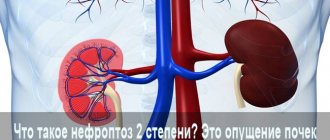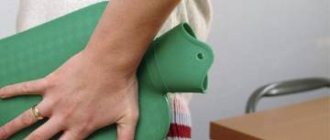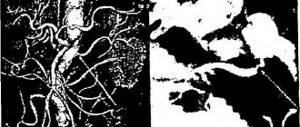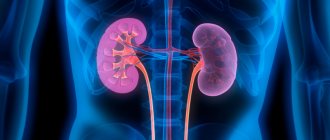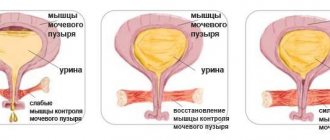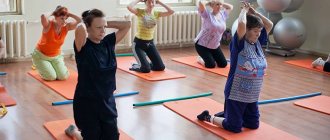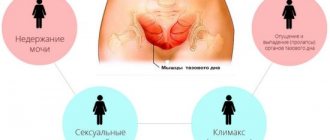Nephroptosis occurs in both young and elderly patients. In the early stages, kidney prolapse does not manifest itself clinically. But grades 2 and 3 of kidney ptosis can become a causative factor in frequent inflammation, the development of chronic pyelonephritis and renal failure as part of chronic kidney disease. Therefore, it becomes important to carry out preventive measures. Massage is used for this. In later stages, surgical correction is performed. But with small changes, they get by by doing exercises when the kidney prolapses.
Characteristics of the disease
The kidneys of those without pathologies are fixed in the renal bed. With nephroptosis, the kidney can move to the abdomen or pelvis. As a result, the vessels stretch and narrow, the ureter becomes bent and blood flow in the organ is disrupted. As a result, a favorable atmosphere is created for urine retention in the organ, and various inflammatory diseases develop.
The pathology can be either the right kidney or the left. The following factors can provoke the disease:
- Sharp loss of kilograms in a short time;
- Injury to the abdomen or lumbar region;
- During gestation and after the baby is born;
- Sedentary work;
- Lifting weights.
At the initial stage of pathology formation, the organ is palpated through the anterior abdominal wall during inhalation. As you exhale, it can be felt in the hypochondrium. At the first stage of nephroptosis, the patient experiences a pulling, aching sensation in the lumbar region on one side. They are felt in a standing position, lying down the pain goes away.
At the second stage, the entire kidney emerges from the hypochondrium in a standing position. When the patient lies down, the organ returns to the desired area. The pain increases and moves to the abdominal area. When a person lies down, the pain subsides.
At the last stage of the disease, the symptoms worsen. The kidney moves out of its zone on a permanent basis, and may even descend into the pelvis. Painful sensations accompany the patient all the time. It does not disappear even in a lying position. The condition worsens after physical overexertion; blood clots may be observed in the urine.
It is better to start treating kidney prolapse in the first stages of the disease. Then it will be possible to avoid surgical intervention and resort only to physical education.
Causes of kidney prolapse
Why do the kidneys droop? Nephroptosis is an acquired pathology, characteristic mainly of women. It develops when pathological changes appear in the apparatus that fixes the kidney. There are many factors that contribute to kidney prolapse, the most common of which are :
- sudden loss of body weight
Due to sudden weight loss over a short period of time (for example, due to an infectious disease, nervous breakdown, strict diet), the renal capsule decreases, which provokes prolapse of the organ.
- injuries in the lumbar region
A common cause of nephroptosis in men is trauma in the lumbar or abdominal area with the formation of hematomas of subcutaneous fat near the kidneys. During the impact, the ligaments that hold the kidney are damaged, which impairs their functioning.
- pregnancy and childbirth
After pregnancy and childbirth, especially multiple ones, a woman’s body undergoes some changes that negatively affect the muscles and ligaments, including those that hold the kidney in the renal bed.
- strength sports
Increased physical activity leads to a sharp increase in intra-abdominal pressure, due to which the ligamentous apparatus fixing the kidney is stretched and ceases to hold the organ normally.
- hard physical work
Work associated with increased physical activity and heavy lifting sooner or later provokes the development of nephroptosis.
- kidney diseases
Sometimes nephroptosis appears due to infectious and inflammatory diseases that affect the kidneys and impair blood circulation in them - pyelonephritis, hydronephrosis, etc.
- hereditary predisposition and diseases
The presence of a congenital defect of the ligamentous apparatus of the kidneys, decreased tone and extensibility of muscles, hypermobility of joints, and underdevelopment of the skeleton can cause the formation of nephroptosis.
People with certain professions are more susceptible to the disease: drivers (low physical activity and constant shaking while driving), loaders (heavy lifting), hairdressers, doctors (staying on their feet for a long time). As mentioned earlier, kidney prolapse most often worries women due to more elastic and flexible ligaments and not as developed muscles and strong abdominal muscles as in men.
Why is physical exercise needed for nephroptosis?
Many patients are interested in whether it is possible to play sports with nephroptosis? Wouldn't this lead to an even greater downward displacement of the internal organs? Highly qualified specialists believe that physical education is one of the most effective methods of combating pathology.
Exercise therapy for nephroptosis is aimed at strengthening ligaments and muscle tissue through daily exercises. It gives effective results. Exercise therapy is also recommended after surgery for nephroptosis. Special exercises will consolidate the results of the operation.
Basic principles of proper physical therapy
Nephroptosis occurs more often in females than in males due to differences in the physiological characteristics of the body. In women, the abdominal muscles are less developed, the connective tissue is more elastic and the fatty capsule of the kidney is smaller.
Exercise therapy for nephroptosis is considered the main component of effective treatment of the disease, but only if surgical treatment is not indicated.
Since today there are many options for exercises - depending on the degree of illness, physical fitness, location of the kidney or concomitant diseases - a specialist selects an individual complex for each patient.
The main goal of physical therapy for nephroptosis is to strengthen the abs, back, sides and return the organ to its anatomically correct position.
Basic rules to follow during classes:
- Do exercises regularly, every day, without skipping.
- One lesson should last 20–30 minutes.
- At any stage of nephroptosis, you should not make sudden movements, run, jump, or lift weights.
- Clothing should be natural, not restricting movement, and you should also prepare a comfortable rug.
- You need to exercise on an empty stomach in the morning. The room should be well ventilated. If the weather permits, classes can be held outside, but always on a flat and hard surface.
- If exercise is accompanied by dizziness or other unpleasant sensations, you should stop and consult a doctor for advice.
- You cannot immediately give a large load, it must be increased gradually.
Experts recommend starting a set of exercises with a warm-up, which will warm up the muscles and prepare the body for further exercise. In addition, heating also has a healing effect.
Class requirements
Nephroptosis and sports are two concepts that are closely related. But to ensure that these methods of therapy are not harmful, it is necessary to follow certain rules:
- It is prohibited to lift weights exceeding 2 kg;
- For grade 2 pathology, you need to wear a bandage. But it is recommended to wear it only when playing sports. Constantly wearing a bandage leads to weakening of muscle tissue;
- After exercises performed while lying on your back, it is recommended to take the knee-elbow position for 10-15 minutes. This will improve urination and blood circulation;
- If you have an illness, you cannot do exercises that involve running or jumping. Twisting and harsh movements can only aggravate the condition.
When you are sick, you need to eat rationally and properly. The fat layer helps the organ stay well in the desired area.
Objectives and principles of exercise therapy
Nephroptosis is a progressive disease, therefore clinically there are three stages. Each of them manifests itself differently, so the tasks of exercise therapy also differ.
Table: tasks of exercise therapy depending on the stage of nephroptosis
- strengthening the tendon-muscular system of the lower back and abdominals;
- improvement of local blood circulation;
- prevention of spinal osteochondrosis;
- return of the kidney to the anatomical bed (for stage I);
- preventing further displacement of the organ, reducing pain (for stage II)
Physical training of a patient with nephroptosis is based on the following principles:
- Regularity. Exercise therapy is effective with an integrated and systematic approach. Trainings are carried out 1-2 times a day. If exercise therapy is performed once a day, its duration is 30–50 minutes. When working out twice, devote up to half an hour to training.
- Correct sequence. The lesson consists of three parts - introductory (warm-up), main (intensive exercises) and final.
- Gradual increase in load. The initial complex, regardless of the stage of nephroptosis, consists of 10–12 special elements, each of which is repeated 2–4 times, alternating with relaxation exercises. The load is gradually increased by introducing additional exercises and increasing the number of repetitions to 10–12 times. As the physical endurance of the student increases, the density of the training increases due to the reduction in the number of relaxation exercises.
When exercise therapy brings a lasting improvement in your condition, as confirmed by instrumental and clinical studies, you cannot refuse classes. Make them a part of your life, since long-term lack of exercise leads to weakening muscle tone. This is especially true for people over 35–40 years of age, in whom age-related changes provoke a decrease in muscle tone and tendon elasticity.
Treatment with gymnastics
There is special therapeutic gymnastics using the Bubnovsky method. The essence of the complex is the implementation of movement therapy and kinesitherapy. According to Bubnovsky’s method, when a renal organ prolapses, the following exercises must be performed:
- In the starting position, lying on your back, raise your lower limbs and press them to your body. Initially, the load should be minimal. Over time, we increase the number of exercises.
- You need to lie on your stomach. Extend your arms in front of you. The legs should be straight, the toes should be pressed. Raise your upper and lower limbs at the same time. Stay in this position for as long as possible. Repeat five to eight times, each time increasing the time of the pose.
- For the next action, the stomach is retracted. The patient lies with his stomach on the ceiling. With his legs it’s as if he’s pedaling a bicycle, but only while lying down. Repeat for two to three minutes.
- Lie down with your stomach down. Gather your hands in a lock at the back of your head. Bend your legs at the knees. Tilt them now to the right, now to the left. The action is repeated in each direction 8 times.
- We repeat this exercise in different directions while exhaling. Lying with your face toward the ceiling, bring your right knee toward your opposite elbow. After this, exhale and relax. Repeat the same in the opposite direction. Repeat the action until fatigue.
To better understand how the exercises are performed, you can watch “Exercise therapy for kidney prolapse in pictures.”
Is it possible to play sports?
Nephroptosis is treated with physical activity, but not all exercise is allowed. Is it possible to play sports with a prolapsed kidney? It is problematic to answer this question unequivocally; it all depends on the type of sports load.
There are such restrictions:
- Do not lift weights weighing more than 3 kg;
- it is forbidden to run, squat, jump, or make sudden movements;
- you cannot play tennis, badminton, kayaking, or participate in timed swimming;
- It is prohibited to exercise on exercise machines or treadmills.
Cycling with nephroptosis is a contraindication. Pain may increase.
With nephroptosis, you can pump up your abs, attend yoga and gymnastics, and swim.
Yoga classes
Yoga, as well as exercise therapy for nephroptosis, helps well in healing. When performing an exercise (any of the above), it is necessary to take into account that all movements are performed slowly, without much effort. For kidney disease, do the following:
- Peacock pose. Bend your knees and sit on your heels with your fifth point. The elbow joints rest against the stomach at the level of the navel. We touch our foreheads to the floor. At the same time, the elbow joints “go” into the stomach, but do not move apart. We remain in this position for several minutes until the body gets used to it. After this, we raise our head, “connecting” our back. Keep your breathing even. The weight of the torso is transferred to the front of the body. The exercise time is 3 minutes or more.
- Staff Pose. Sit on the floor or mat. Extend your legs forward. Put your socks together. As you inhale deeply, bend your torso forward towards your toes. You need to use your entire body. If you do not feel pain, then you can clasp your feet with your hands.
There are many more yoga poses that can help cure kidney prolapse. Yoga with abdominal exercises helps strengthen not only the kidney organ, but also the heart and bladder. But remember, everything is good in moderation. Don't do any exercise that could harm you.
Physical activity during stage II kidney displacement
The second stage of nephroptosis is more difficult than the first. Therefore, you need to perform the exercises from a supine position in such a way that the lower part of the body is raised by 25-30 degrees in order to return the lowered kidney to its place. This is possible on the Evminov board or by placing a cushion under the lower back in the main part of the lesson. Movements are made smoothly. The emphasis is not on quantity, but on quality of execution. The ratio of general developmental exercises to special ones is initially 1:1, then 1:2.
Those who have experienced nephroptosis know firsthand about the dangers that this disease poses. Therefore, the sooner treatment is started, the better the prognosis for the patient. One of the main methods of conservative treatment of kidney prolapse is exercise therapy.
Specialized exercises for nephroptosis strengthen the muscular frame of the back and abdominals, and help restore the normal arrangement of the organs of the urinary system. In our review, we will consider the general provisions of physical therapy for raising sagging kidneys and analyze the most effective exercises.
Basic set of exercises
Physical therapy for kidney prolapse (nephroptosis) contains a basic set of exercises. The action of which is aimed at strengthening muscle tissue and restoring normal blood flow. Exercises must be done daily. Lying on your back, do the following exercises:
- The legs are connected together, with straight arms lying along the body. As you inhale, bring your arms through your sides into a lock at the back of your head.
- As you exhale, pull your legs down and your hands up.
- We open the lock. We place our hands palms up. In this case, the hand position is: widely spaced. With even breathing, we raise our legs perpendicular to the horizontal surface.
- As we exhale, we spread our arms to the sides. We try to press the pelvis to the floor. We hold our legs at 90 degrees.
- As you exhale, tilt your legs to the right side, twisting your torso completely. At the same time, the head should turn in the opposite direction, without tearing the left shoulder off the horizontal surface. The lower limbs are lowered until there is a feeling that you need to raise them back up. It is better to fix them at a height of 10–12 cm above the right palm. As you inhale, slowly return your legs back.
General recommendations
One of the main requirements for successful treatment of nephroptosis is maintaining correct posture. The latter is precisely maintained due to the work of stabilizer muscles. A stooped back, a tilted neck, and a rounded lower back are indispensable participants in the development of the disease.
In practice, all physical therapy comes down to teaching a weakened patient how to maintain correct posture and strengthening the muscles for this. What else should be observed?
- Bandage is not a panacea. Moreover, wearing it leads to even greater weakening of the muscles. So you should wear a corset only as a last resort, when there is some kind of physical activity or when it is necessary to protect the kidneys from mechanical factors. For example, riding a bus is accompanied by strong jolts and jerks. Here, a bandage will not hurt, and then only at stages 2 and 3.
- Gymnastics must be performed every day, even better - 2 per day. Moreover, the second complex should be longer.
- To strengthen muscles, they need to be loaded, so fatigue and sore muscles are a prerequisite. But if muscle pain is a positive factor, then kidney pain is not. When performing the exercise, you should carefully monitor what exactly and where it hurts. In addition, if there are other ailments, then when performing exercises their influence must also be taken into account.
- Exercises in the knee-elbow position may cause dizziness. It is important to establish its cause. If this is associated with an increase in pressure provoked by nephroptosis, the “cat” procedure will have to be postponed. If this is a consequence of cervical or thoracic osteochondrosis, it is necessary to continue, but slowly and with an exhalation “ha-a-a.” The exhalation technique must be mastered, as it relieves pressure.
- The load must constantly increase. If after 2 months exercise therapy seems too simple, you need to include more complex exercises, and even with weights - ankle bracelets, for example. Gradually, regular strength exercises are being introduced into gymnastics - for healthy people.
Exercise therapy is an absolutely necessary element in the treatment of nephroptosis, even of grade 3 severity. Therapeutic gymnastics does not provide a sufficient effect only if, as a result of prolapse, the kidney is affected by a serious illness - hydronephrosis, pyelonephrosis.
Morning work-out
Exercise therapy for nephroptosis (prolapse of the kidneys) must be done daily. Physical education should be done in the morning. You need to spend half an hour charging:
- In a lying position with your stomach up, slightly bend your knees. As you inhale, push your stomach forward. As you exhale, draw in. Repeat five to ten times.
- Lying on your back, lift each leg up in turn. Five to eight times each.
- Get into a knee-elbow position. Do the “evil” and “good” cat exercise. Strongly arch your spine upward, and then bend in the opposite direction. After this, you need to return to the starting position. Repeat the exercise four to six times. With any of the above movements, you strengthen muscle tissue.
Gymnastic exercises for the correction of nephroptosis
The duration of exercises for nephroptosis should be at least 30 minutes, so each of them must be repeated sequentially at least 10 times. It is recommended to perform the entire complex in the morning, for this:
1. Lying on your back, your legs need to be bent, your knees should be placed straight, at a distance of 30 cm from each other. Take a big breath, stick out your stomach. Hold your breath for a few seconds, and as you exhale, pull your stomach back in.
2. Take the starting position. When inhaling, straighten your legs vertically upward, when exhaling, lower them.
3. Lying on your back, you need to raise your legs, while bringing your knees together. Spread your legs to the sides, inhaling, cross as you exhale. In fitness, this exercise is called “scissors” - it helps to strengthen the anterior abdominal wall and oblique abdominal muscles.
4. Prepare a cushion or pillow. Lying on your back, place one of them under your lumbar back. After inhaling, bend the right leg and lower it only as you exhale. Repeat the same actions with your left foot.
5. Take a position on your back, put your hands at your sides, bend your legs at the knees (feet should be on the floor). Alternately raise your left and right legs.
6. In a lying position, legs are bent. Place a ball between the knee joints and squeeze it intensely for several seconds.
These training recommendations, which include ideal exercises for grade 1 nephroptosis, do not have a therapeutic effect, but a corrective effect. If the entire gymnastic complex is performed correctly, aching pain should decrease not only in a lying position, but also during everyday life. The kidney can be felt when inhaling through the abdominal wall if the patient is sufficiently thin. In other cases it is not palpable.
Exercises for grade 2 nephroptosis should be performed with extreme caution, since, given the similarity of pain, the pathology can easily be mistaken for appendicitis. The pain becomes intense, spreading to the abdominal area. In a vertical position, the kidney comes out completely from the hypochondrium. Returns to its original position when the patient is lying down. There is a bend in the ureter, as a result of which the outflow of urine becomes difficult.
Stagnant fluid is a favorable environment for the proliferation of pathogens that provoke pyelonephritis. If you do not pay attention to it in a timely manner, complications will arise. It is impossible to perform exercise therapy for pyelonephritis, if it is complicated by kidney prolapse: it is recommended to adhere to bed rest until body temperature normalizes.
In addition to exercises, the attending physician prescribes a regimen of medications and wearing a special bandage that prevents the kidney from “wandering.” Complex treatment also includes a course of relieving massage, which is recommended to be performed very carefully in tandem with exercises for grade 3 nephroptosis. The kidney can descend into the pelvic area in any position. After physical activity, the urine contains blood. Patients may constantly complain of abdominal pain radiating to the lumbar region.
Preventive exercises
As mentioned earlier, nephroptosis can occur in anyone, so physical exercise is recommended for preventive purposes. Gymnastics helps not only with kidney pathology, but also with many other diseases.
But it is necessary to take into account that physical exercises during kidney prolapse must be performed strictly according to the instructions. Legs and arms should be at the right height, exercises for the abdominal muscles should not cause pain, etc. In order for exercises to bring effective results, you also need to eat right, lead a healthy lifestyle, be outdoors more often, and do a special massage.
Important Patient Information
Despite the fact that physical therapy for kidney diseases is considered gentle and is usually well tolerated by patients, there are nuances that are important to know:
- Do not perform exercises on a full stomach: this can cause gastrointestinal problems.
- If during the exercises you feel discomfort, nagging pain in the lower back, or feel dizzy, stop immediately. In the future, be sure to consult your doctor.
- In consultation with your nephrologist, after training, wear a bandage belt that will help fix the urinary organs in the correct position.
- Diaphragmatic breathing also helps train the abdominal muscles. It is carried out by inflating the abdomen during inhalation and retracting it during exhalation. This breathing can be used before, during and after training.
Exercise therapy for kidney prolapse is effective not only for eliminating unpleasant symptoms of the disease, but also for preventing serious complications. A strong muscular frame is able to hold the kidney in a physiological position and prevent its further prolapse.
In addition to physical therapy, complex therapy for nephroptosis should include the prevention of urinary tract infections, adherence to the principles of a healthy lifestyle and a diet with a predominant consumption of dairy and plant foods. With careful attention to your health, the prognosis for patients with kidney prolapse remains favorable.
Exercises for kidney prolapse help to cope with the problem quickly enough. After all, this pathology is quite serious and can lead to complications. Prolapse of the kidney, or nephroptosis, is accompanied by the movement of an important organ of the human body from its usual place to the pelvic area. Most often, such problems are observed in women, although such patients can also be found among men.
Fortunately, experts have developed sets of exercises that will help cope with the pathology. The article describes all the recommended complexes, and also contains information about what exercises should not be done if the kidney is prolapsed. In order not to further harm your health, you should carefully read this article and, having prepared for health activities, begin self-treatment.
People begin to perform exercises for prolapsed kidney, which is also called nephroptosis or “wandering kidney,” when they notice some unpleasant internal sensations. As a rule, during inhalation and exhalation, the kidneys can move literally a couple of centimeters, but if a larger displacement occurs, the person immediately feels discomfort.
When a patient turns to a doctor for help, he must take tests and undergo a professional examination, which helps make a diagnosis. Of course, not everyone wants to go to the hospital for long-term treatment, so exercises come to the rescue when the kidneys are drooping. They manifest themselves in the same way in women and men, but the symptoms are described in more detail below.
Additional recommendations when performing physical exercises
Important information for those doing the exercises:
- Despite the fact that such gymnastics is considered the safest, exercises should not be done immediately after eating;
- Classes must be regular. You cannot miss a single day;
- If you feel pain while doing exercises, you should stop exercising and immediately get a doctor’s opinion on this matter;
In addition to therapeutic exercises, exercises in the pool also help with nephroptosis. Long walks in the fresh air.
What to consider when performing such gymnastics
Exercises for nephroptosis are considered one of the safest types of physical education. However, you still need to carefully prepare for it. You should not do gymnastics immediately after eating - you can cause problems with the digestive system.
The benefits of gymnastics for kidney diseases are undeniable. However, the effect can be achieved only if you maintain regularity of actions. This means that you need to practice every day. On average, such a charge will take you about 25 minutes, so it’s possible to find time for it even in a busy schedule.
If during the exercises you experience strange sensations, for example, dizziness (when performing the same “Cat”) or darkening in your eyes, and also if you feel pain, you should stop. Be sure to see a doctor after this.
Photo from propochki.info
But a complex of physical therapy will be effective only when it is selected by a specialist, taking into account the degree of prolapse. In severe cases, physical activity will cause harm instead of benefit.
Important execution features
The treatment complex can be supplemented with massage procedures.
- Step-by-step instructions with a gradual increase in intensity are selected by a specialist.
- Exercises to raise the kidneys are performed regularly, every day, preferably at the same time.
- If you feel worse, you should stop charging immediately.
- Exercise therapy is performed in comfortable, sportswear in comfortable conditions.
- The duration of the lesson should not exceed 30 minutes.
- Training is carried out in the morning on an empty stomach.
- Before intense and active physical activity, all muscle groups should be thoroughly warmed up.
- Massage, long walks and swimming will perfectly complement the complex.
